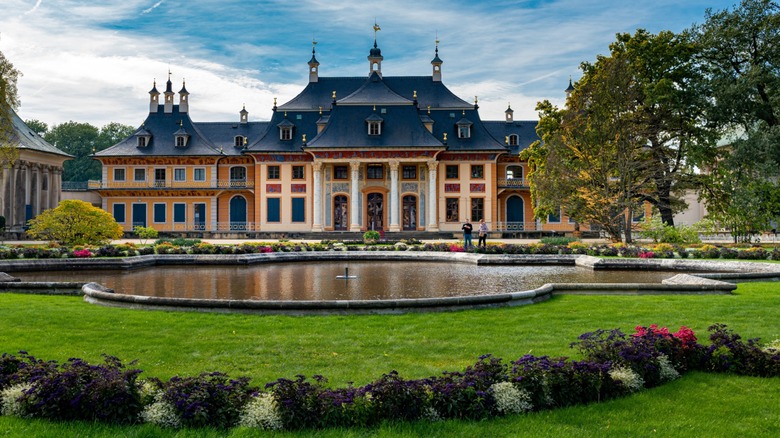A Family-Friendly Three Palace Park In Dresden, Germany Is A Treat For The Eyes And Nose
The exquisite Pillnitz Palace and Park, which lies along the Elbe River in Germany's Saxony region, is a sight to behold. Containing three palaces, several gardens, a temple, a church, two museums, and more, the estate's sprawling 69-acre property attracts visitors year-round and is the perfect spot for a family day trip. The Palm House in particular, an enormous and beautifully designed greenhouse, will enchant visitors young and old with its exotic flora from South Africa, New Zealand, and Australia. A special treat for plant enthusiasts is the Japanese camellia, which dates back around 250 years. Every spring, this 30-foot beauty produces tens of thousands of vibrant pink and red carmine flowers, which emit a wonderfully fragrant smell. They can best be admired when they're in full bloom from mid-February until mid-April.
The estate that can be seen today dates back to the 1700s, although there's evidence that a fortress existed here as early as the 14th century. Two of the oldest buildings, the Riverside Palace and the Hillside Palace, were built between 1720 and 1724. Inside both, you will find exhibitions from the Museum of Decorative Arts. View the elegant Yellow Tearoom for a window into the lives of Saxon nobility at this time. The "Chinoiserie" style — a European interpretation of Asian design elements and motifs — was all the rage during this period, and this room perfectly displays a beautiful combination of Chinoiserie style and Baroque architecture.
Upon leaving the Riverside Palace, the grand Monumental Staircase brings you down to the idyllic Elbe. The New Palace, which is centered between the other two, is where you can find the Palace Museum. Once inside, take in the ornate domed hall built in the neoclassical style — the only one of its kind in the region.
Pillnitz Palace's unbelievable and fascinating history
Behind the palace's peaceful façade lies a salacious and decidedly un-family-friendly history worthy of a "Game of Thrones" episode. In 1694, Elector John George IV purchased the property for his mistress, Magdalena Sibylla von Neitschütz, who was rumored to also be his half-sister. Both died of smallpox shortly after moving into the residence, and Magdalena's mother was accused of and tried for witchcraft the following year.
Following these untimely deaths, the elector's brother, Augustus the Strong, acquired the castle and intended to gift it to his mistress, the Countess of Cosel. Thus began the process of converting the property into the Baroque beauty that it is today. But for a number of reasons, including political interference and Augustus' waning interest in the countess, she was banished to Berlin, where she remained in exile until her death nearly 50 years later.
Pillnitz Palace, meanwhile, continued to be restored by Augustus during the 1720s in accordance with plans laid out by famed architect Matthäus Daniel Pöppelmann. Augustus, ever the consummate entertainer, used this residence primarily as a pleasure palace for members of the court. He hosted games and parties, where nobles were invited to cosplay as peasants and wine merchants for their own amusement. Over the years, Pillnitz Palace was passed down through the generations of Augustus' family (the Wettin Dynasty) as a summer residence. But since the end of World War II, the palace has been open to the public as a park and museum — so now the splendor of the grounds that were fit for kings, princes, and countesses (and alleged witches) can be enjoyed by all.
Planning your visit
Pillnitz Palace and Park is located in the south of Dresden, a historically and culturally significant eastern German city that is the site of one of the most spectacular Christmas markets in the world. It can be accessed by car, bus, tram, and even boat. If you're driving, take the Dresden-Hellerau or Dresden-Altstadt exit from Motorway A4 or the Pirna exit from Motorway A17.
The various buildings have different operating hours and fees, so it's best to check the official website for the most up-to-date information. As of the time of writing, the park opens from 6 a.m. until 3 p.m. and is free of charge in the winter; from March until October, it closes at dusk and requires a fee for adults to enter until 6 p.m. The Palace Museum and the Museum of Decorative Arts are open from May to October, Tuesday through Sunday and on holidays, from 10 a.m. to 6 p.m. Outside of those months, only the Palace Museum is open and just for guided tours on weekends and holidays. Entrance to the museums requires an additional fee, though children aged 16 and younger can visit for free. The Palm House is accessible year-round, though hours vary by season.
If you're looking to explore the surrounding area, Schloss Wackerbarth, an adventure winery in the scenic countryside, is less than an hour northwest of Pillnitz. And if you're not tired of castles yet, Moritzburg, a gorgeous 16th-century hunting lodge turned fairytale palace, is just 20 minutes away from Schloss Wackerbarth — so it's possible to visit all of these enchanting estates in a single weekend trip.


